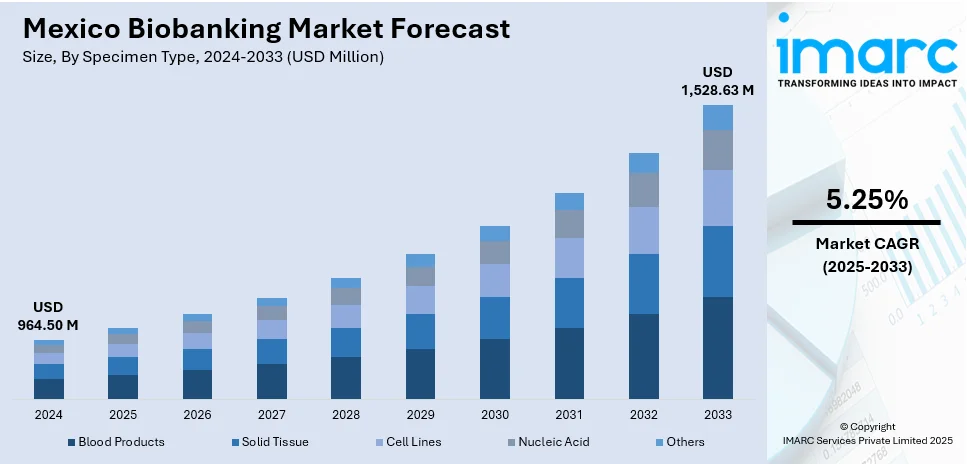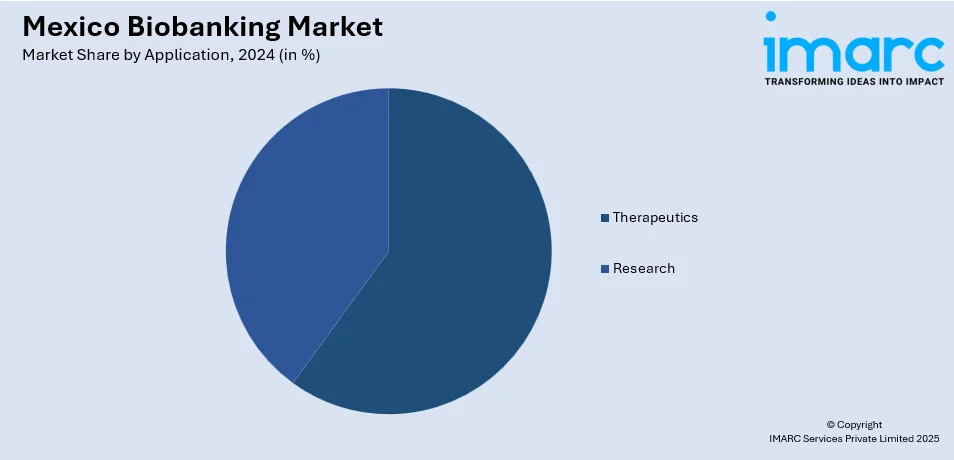
Mexico Biobanking Market Size, Share, Trends and Forecast by Specimen Type, Biobank Type, Application, End User, and Region, 2025-2033
Mexico Biobanking Market Overview:
The Mexico biobanking market size reached USD 964.50 Million in 2024. Looking forward, IMARC Group expects the market to reach USD 1,528.63 Million by 2033, exhibiting a growth rate (CAGR) of 5.25% during 2025-2033. The market is driven by government-sponsored research projects, genetic advancements, and the growing need for personalized medicine. Enhanced healthcare infrastructure, advances in sample storage and management technology, and increasing interest in precision medicine also help support Mexico biobanking market share that aids domestic as well as international research.
|
Report Attribute
|
Key Statistics
|
|---|---|
|
Base Year
|
2024
|
|
Forecast Years
|
2025-2033
|
|
Historical Years
|
2019-2024
|
| Market Size in 2024 | USD 964.50 Million |
| Market Forecast in 2033 | USD 1,528.63 Million |
| Market Growth Rate 2025-2033 | 5.25% |
Mexico Biobanking Market Trends:
Expansion of National Genomic Initiatives
Mexico is investing a lot of money on national genomic research, with the goal of expanding our understanding of the nation's genetic diversity. The goal of national biobank initiatives, like the Mexican Biobank project, is to gather a diverse range of genetic data from people all around the country. By helping to identify genetic vulnerability to certain diseases, these studies open the door to precision medication tailored to the Mexican population. These efforts are expected to significantly improve illness prevention, diagnosis, and treatment strategies by linking genetic information with health outcomes. The growing focus on genomics is creating a foundation for innovative studies understanding of genetics and health inequities contributing to the Mexico biobanking market growth.

Growth in Biobanking Infrastructure and Technology
Modern technologies are being used more and more by biobanks in Mexico to enhance their operations and guarantee the integrity of biological samples. Automation technologies that simplify sample processing and tracking are among them, as are sophisticated storage systems and data management tools. One significant trend is the growth of Laboratory Information Management Systems (LIMS), which aid in streamlining sample retrieval and data collecting. Biobanks are now more dependable for clinical trials, research, and medical applications because to these advancements, which also increase efficiency. With the growing need for high-quality biological data, these technical developments will be essential to preserving the precision and usability of biobank resources.
Emphasis on Precision Medicine and Public Health Research
There is an increasing emphasis placed on exploiting biobanks to enable precision medicine in Mexico, with specific initiatives such as the Mexican Biobank Project. By incorporating genetic, health, and environmental information, biobanks are making possible more customized healthcare interventions adapted to the genetic makeup of individuals. This aspect is particularly crucial for Mexico's heterogeneous population where specific genetic determinants contribute to health risks like diabetes, cardiovascular illness, and other chronic diseases. The Mexican Biobank Project has genotyped 6, 057 people from 898 municipalities in all 32 states with a broad coverage of rural and urban populations. The large sample is important for the identification of genetic differences among different regions to facilitate the creation of targeted treatments, enhance prevention strategies, and maximize health benefits. This initiative is consistent with international trends in precision medicine and places Mexico at the forefront of developing individualized healthcare solutions.
Mexico Biobanking Market Segmentation:
IMARC Group provides an analysis of the key trends in each segment of the market, along with forecasts at the country and regional for 2025-2033. Our report has categorized the market based on specimen type, biobank type, application, and end user.
Specimen Type Insights:
- Blood Products
- Solid Tissue
- Cell Lines
- Nucleic Acid
- Others
The report has provided a detailed breakup and analysis of the market based on the specimen type. This includes blood products, solid tissue, cell lines, nucleic acid, and others
Biobank Type Insights:
- Population-based Biobanks
- Disease-oriented Biobanks
A detailed breakup and analysis of the market based on the biobank type have also been provided in the report. This includes population-based biobanks and disease-oriented biobanks.
Application Insights:

- Therapeutics
- Research
The report has provided a detailed breakup and analysis of the market based on the application. This includes therapeutics and research.
End User Insights:
- Academic Institutions
- Pharma and Biotech Companies
A detailed breakup and analysis of the market based on the end user have also been provided in the report. This includes academic institutions and pharma and biotech companies.
Regional Insights:
- Northern Mexico
- Central Mexico
- Southern Mexico
- Others
The report has also provided a comprehensive analysis of all the major regional markets, which include Northern Mexico, Central Mexico, Southern Mexico, and Others.
Competitive Landscape:
The market research report has also provided a comprehensive analysis of the competitive landscape. Competitive analysis such as market structure, key player positioning, top winning strategies, competitive dashboard, and company evaluation quadrant has been covered in the report. Also, detailed profiles of all major companies have been provided.
Mexico Biobanking Market News:
- In March 2025, The OriGen Health Research Center, a collaboration between Tec de Monterrey and The University of Texas at Austin, is using Latin America's largest biobank and AI to address Latino health disparities. By studying genetic and clinical factors influencing chronic diseases like diabetes, obesity, and cardiovascular disease, researchers aim to develop personalized treatments and predictive models. The initiative focuses on culturally relevant solutions for Latino communities in both Latin America and the U.S.
Mexico Biobanking Market Report Coverage:
| Report Features | Details |
|---|---|
| Base Year of the Analysis | 2024 |
| Historical Period | 2019-2024 |
| Forecast Period | 2025-2033 |
| Units | Million USD |
| Scope of the Report |
Exploration of Historical Trends and Market Outlook, Industry Catalysts and Challenges, Segment-Wise Historical and Future Market Assessment:
|
| Specimen Types Covered | Blood Products, Solid Tissue, Cell Lines, Nucleic Acid, Others |
| Biobank Types Covered | Population-based Biobanks, Disease-oriented Biobanks |
| Applications Covered | Therapeutics, Research |
| End Users Covered | Academic Institutions, Pharma and Biotech Companies |
| Regions Covered | Northern Mexico, Central Mexico, Southern Mexico, Others |
| Customization Scope | 10% Free Customization |
| Post-Sale Analyst Support | 10-12 Weeks |
| Delivery Format | PDF and Excel through Email (We can also provide the editable version of the report in PPT/Word format on special request) |
Key Questions Answered in This Report:
- How has the Mexico biobanking market performed so far and how will it perform in the coming years?
- What is the breakup of the Mexico biobanking market on the basis of specimen type?
- What is the breakup of the Mexico biobanking market on the basis of biobank type?
- What is the breakup of the Mexico biobanking market on the basis of application?
- What is the breakup of the Mexico biobanking market on the basis of end user?
- What is the breakup of the Mexico biobanking market on the basis of region?
- What are the various stages in the value chain of the Mexico biobanking market?
- What are the key driving factors and challenges in the Mexico biobanking?
- What is the structure of the Mexico biobanking market and who are the key players?
- What is the degree of competition in the Mexico biobanking market?
Key Benefits for Stakeholders:
- IMARC’s industry report offers a comprehensive quantitative analysis of various market segments, historical and current market trends, market forecasts, and dynamics of the Mexico biobanking market from 2019-2033.
- The research report provides the latest information on the market drivers, challenges, and opportunities in the Mexico biobanking market.
- Porter's five forces analysis assist stakeholders in assessing the impact of new entrants, competitive rivalry, supplier power, buyer power, and the threat of substitution. It helps stakeholders to analyze the level of competition within the Mexico biobanking industry and its attractiveness.
- Competitive landscape allows stakeholders to understand their competitive environment and provides an insight into the current positions of key players in the market.
Need more help?
- Speak to our experienced analysts for insights on the current market scenarios.
- Include additional segments and countries to customize the report as per your requirement.
- Gain an unparalleled competitive advantage in your domain by understanding how to utilize the report and positively impacting your operations and revenue.
- For further assistance, please connect with our analysts.
 Request Customization
Request Customization
 Speak to an Analyst
Speak to an Analyst
 Request Brochure
Request Brochure
 Inquire Before Buying
Inquire Before Buying




.webp)




.webp)












